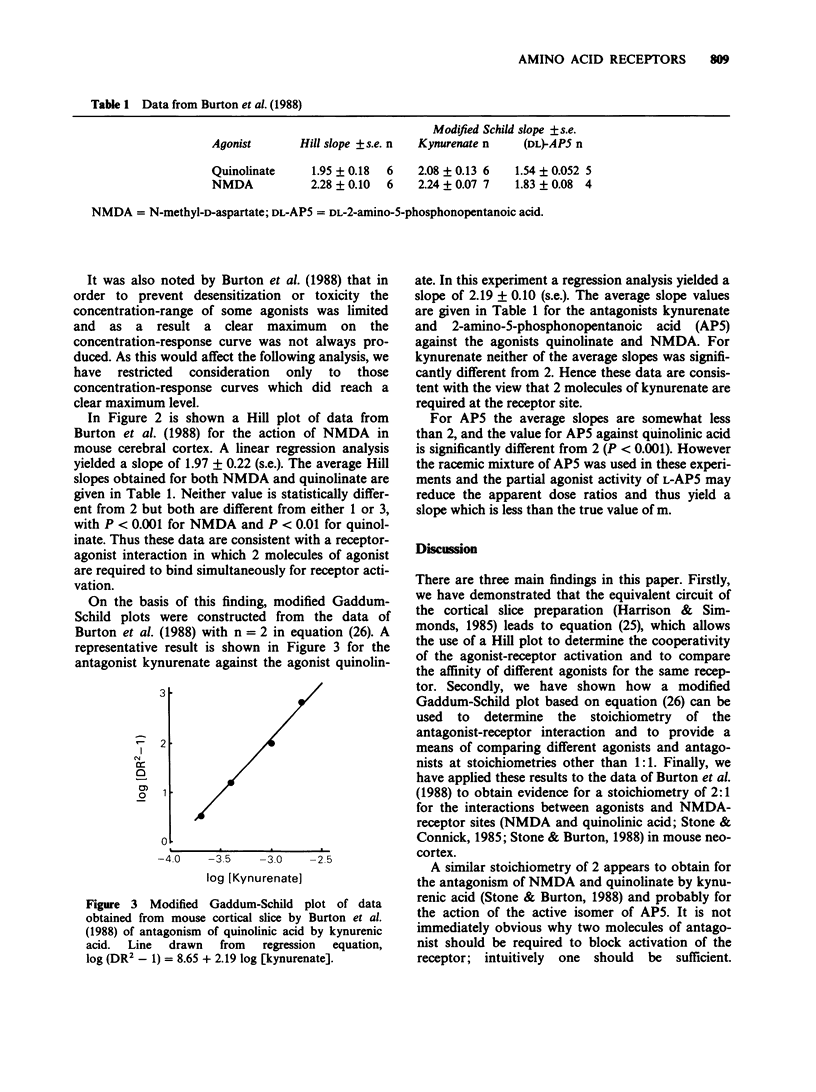Abstract
1. The equivalent circuit of the cortical slice preparation has been analysed to show that the measured d.c. voltages can be used to estimate the Hill coefficient for ligands acting on the pyramidal cell bodies. 2. The Gaddum-Schild equation for agonist-antagonist interactions has been modified for applications in which the Hill coefficient is not equal to 1. 3. The equations obtained have been applied to recent data of Burton et al. (1988). The results provide evidence for a bimolecular action of the agonists N-methyl-D-aspartate (NMDA) and quinolinic acid and the antagonists kynurenic acid and 2-amino-5-phosphono-pentanoic acid at NMDA receptors on mouse neocortical pyramidal cells.
Full text
PDF





Selected References
These references are in PubMed. This may not be the complete list of references from this article.
- ARUNLAKSHANA O., SCHILD H. O. Some quantitative uses of drug antagonists. Br J Pharmacol Chemother. 1959 Mar;14(1):48–58. doi: 10.1111/j.1476-5381.1959.tb00928.x. [DOI] [PMC free article] [PubMed] [Google Scholar]
- Burton N. R., Smith D. A., Stone T. W. A quantitative pharmacological analysis of some excitatory amino acid receptors in the mouse neocortex in vitro. Br J Pharmacol. 1988 Mar;93(3):693–701. doi: 10.1111/j.1476-5381.1988.tb10328.x. [DOI] [PMC free article] [PubMed] [Google Scholar]
- Clark A. J. The reaction between acetyl choline and muscle cells. J Physiol. 1926 Aug 6;61(4):530–546. doi: 10.1113/jphysiol.1926.sp002314. [DOI] [PMC free article] [PubMed] [Google Scholar]
- Evans R. H., Watkins J. C. Specific antagonism of excitant amino acids in the isolated spinal cord of the neonatal rat. Eur J Pharmacol. 1978 Jul 15;50(2):123–129. doi: 10.1016/0014-2999(78)90007-9. [DOI] [PubMed] [Google Scholar]
- Gaddum J. H. The action of adrenalin and ergotamine on the uterus of the rabbit. J Physiol. 1926 Mar 18;61(1):141–150. doi: 10.1113/jphysiol.1926.sp002280. [DOI] [PMC free article] [PubMed] [Google Scholar]
- Harrison N. L., Simmonds M. A. Quantitative studies on some antagonists of N-methyl D-aspartate in slices of rat cerebral cortex. Br J Pharmacol. 1985 Feb;84(2):381–391. doi: 10.1111/j.1476-5381.1985.tb12922.x. [DOI] [PMC free article] [PubMed] [Google Scholar]
- Rang H. P. Drug receptors and their function. Nature. 1971 May 14;231(5298):91–96. doi: 10.1038/231091a0. [DOI] [PubMed] [Google Scholar]
- Stone T. W., Burton N. R. NMDA receptors and ligands in the vertebrate CNS. Prog Neurobiol. 1988;30(4):333–368. doi: 10.1016/0301-0082(88)90027-5. [DOI] [PubMed] [Google Scholar]
- Stone T. W., Connick J. H. Quinolinic acid and other kynurenines in the central nervous system. Neuroscience. 1985 Jul;15(3):597–617. doi: 10.1016/0306-4522(85)90063-6. [DOI] [PubMed] [Google Scholar]


